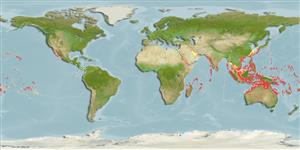Common names from other countries
>
Holocentriformes (Squirrelfishes, soldierfishes) >
Holocentridae (Squirrelfishes, soldierfishes) > Holocentrinae
Etymology: Sargocentron: Greek, sargos = sargus + Greek, kentron = sting (Ref. 45335).
More on authors: Jordan & Fowler.
Environment: milieu / climate zone / depth range / distribution range
Ökologie
seewasser riff-verbunden; tiefenbereich 5 - 190 m (Ref. 117152), usually 5 - 70 m (Ref. 9710). Tropical; 35°N - 24°S
Indo-Pacific: Red Sea and Natal, South Africa (Ref. 4201) to the Marquesan Islands, north to southern Japan and the Ogasawara Islands, south to New South Wales, Australia.
Size / Gewicht / Alter
Maturity: Lm ? range ? - ? cm
Max length : 20.0 cm TL Männchen/unbestimmt; (Ref. 9710)
Rückenflossenstacheln (insgesamt): 11; Rückenflossenweichstrahlen (insgesamt): 13-14; Afterflossenstacheln 4; Afterflossenweichstrahlen: 8 - 10. Body with red and white stripes following the scale rows, the red stripes slightly narrower than the white ones (Ref. 4201) (red stripes usually broader for Taiwan and Japan specimens); lateral line scales for northern Philippines, Taiwan and Japan specimens 44-49; 5 oblique rows of scales on cheek; body depth 2.8-3.1 in SL; head length 2.8-3.1 in SL; short snout, 3.65-4.15 in head length; interorbital width 4.3-4.65 in head length; maxilla extending from below front of pupil to below center of eye, upper jaw length 2.6-2.9 in head length; premaxillary groove reaching about a vertical at anterior edge of orbit; rounded anterior end of nasal bone; edge of small nasal fossa without spine; median edge of nasal bone (premaxillary groove margin) without spinule; upper edge of suborbital bones below the eye weakly serrated and without lateral spine; short preopercular spine, about 1/3 orbit diameter, 5.5-8.2 in head diameter; 4th or 5th longest dorsal spines, 1.7-2.2 in head length; third anal spine long, 1.15-1.4 in head length (Ref. 27370).
Occurs in outer reef slopes. A nocturnal species that feeds mainly on benthic crabs and shrimps. Spine of preopercle venomous. Solitary or in groups (Ref 90102).
Life cycle and mating behavior
Geschlechtsreife | Fortpflanzung | Ablaichen | Eier | Fecundity | Larven
Randall, J.E., 1998. Revision of the Indo-Pacific squirrelfishes (Beryciformes: Holocentridae: Holocentrinae) of the genus Sargocentron, with descriptions of four new species. Indo-Pac. Fish. (27):105 p. (Ref. 27370)
IUCN Rote Liste Status (Ref. 130435)
CITES (Ref. 128078)
Not Evaluated
Nutzung durch Menschen
Mehr Information
NamenSynonymeMetabolismusRäuberÖkotoxikologieFortpflanzungGeschlechtsreifeAblaichenFecundityEierEientwicklung
ReferenzenAquakulturAquakultur ProfilZuchtlinienGenetikElectrophoresesVererbbarkeitKrankheitenVerarbeitungMass conversion
PartnerBilderStamps, Coins Misc.LauteCiguateraGeschwindigkeitSchwimmstilKiemenoberflächeOtolithsGehirngrößeSehfähigkeit
Tools
Zusatzinformationen
Download XML
Internet Quellen
Estimates based on models
Preferred temperature (Ref.
115969): 24.7 - 29, mean 27.9 (based on 632 cells).
Phylogenetic diversity index (Ref.
82804): PD
50 = 0.5000 [Uniqueness, from 0.5 = low to 2.0 = high].
Bayesian length-weight: a=0.01622 (0.00774 - 0.03400), b=2.97 (2.80 - 3.14), in cm Total Length, based on LWR estimates for this Genus-body shape (Ref.
93245).
Trophic level (Ref.
69278): 3.6 ±0.60 se; based on food items.
Widerstandsfähigkeit (Ref.
120179): hoch, Verdopplung der Population dauert weniger als 15 Monate. (Preliminary K or Fecundity.).
Fishing Vulnerability (Ref.
59153): Low vulnerability (10 of 100).
